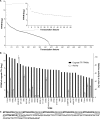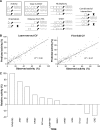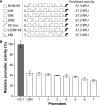In silico design of context-responsive mammalian promoters with user-defined functionality
- PMID: 28977454
- PMCID: PMC5737543
- DOI: 10.1093/nar/gkx768
In silico design of context-responsive mammalian promoters with user-defined functionality
Abstract
Comprehensive de novo-design of complex mammalian promoters is restricted by unpredictable combinatorial interactions between constituent transcription factor regulatory elements (TFREs). In this study, we show that modular binding sites that do not function cooperatively can be identified by analyzing host cell transcription factor expression profiles, and subsequently testing cognate TFRE activities in varying homotypic and heterotypic promoter architectures. TFREs that displayed position-insensitive, additive function within a specific expression context could be rationally combined together in silico to create promoters with highly predictable activities. As TFRE order and spacing did not affect the performance of these TFRE-combinations, compositions could be specifically arranged to preclude the formation of undesirable sequence features. This facilitated simple in silico-design of promoters with context-required, user-defined functionalities. To demonstrate this, we de novo-created promoters for biopharmaceutical production in CHO cells that exhibited precisely designed activity dynamics and long-term expression-stability, without causing observable retroactive effects on cellular performance. The design process described can be utilized for applications requiring context-responsive, customizable promoter function, particularly where co-expression of synthetic TFs is not suitable. Although the synthetic promoter structure utilized does not closely resemble native mammalian architectures, our findings also provide additional support for a flexible billboard model of promoter regulation.
© The Author(s) 2017. Published by Oxford University Press on behalf of Nucleic Acids Research.
Figures





Similar articles
-
CHO genome mining for synthetic promoter design.J Biotechnol. 2019 Mar 20;294:1-13. doi: 10.1016/j.jbiotec.2019.01.015. Epub 2019 Jan 28. J Biotechnol. 2019. PMID: 30703471
-
Synthetic promoters for CHO cell engineering.Biotechnol Bioeng. 2014 Aug;111(8):1638-47. doi: 10.1002/bit.25227. Epub 2014 May 1. Biotechnol Bioeng. 2014. PMID: 24615264
-
Constructing Strong Cell Type-Specific Promoters Through Informed Design.Methods Mol Biol. 2017;1651:131-145. doi: 10.1007/978-1-4939-7223-4_10. Methods Mol Biol. 2017. PMID: 28801904
-
Precision control of recombinant gene transcription for CHO cell synthetic biology.Biotechnol Adv. 2016 Sep-Oct;34(5):492-503. doi: 10.1016/j.biotechadv.2015.12.012. Epub 2015 Dec 23. Biotechnol Adv. 2016. PMID: 26721629 Review.
-
Plant synthetic promoters and transcription factors.Curr Opin Biotechnol. 2016 Feb;37:36-44. doi: 10.1016/j.copbio.2015.10.001. Epub 2015 Oct 31. Curr Opin Biotechnol. 2016. PMID: 26524248 Review.
Cited by
-
A modular degron library for synthetic circuits in mammalian cells.Nat Commun. 2019 May 1;10(1):2013. doi: 10.1038/s41467-019-09974-5. Nat Commun. 2019. PMID: 31043592 Free PMC article.
-
Control of Multigene Expression Stoichiometry in Mammalian Cells Using Synthetic Promoters.ACS Synth Biol. 2021 May 21;10(5):1155-1165. doi: 10.1021/acssynbio.0c00643. Epub 2021 May 3. ACS Synth Biol. 2021. PMID: 33939428 Free PMC article.
-
A Multifaceted Approach to Optimizing AAV Delivery to the Brain for the Treatment of Neurodegenerative Diseases.Front Neurosci. 2021 Sep 24;15:747726. doi: 10.3389/fnins.2021.747726. eCollection 2021. Front Neurosci. 2021. PMID: 34630029 Free PMC article.
-
A synthetic transcription platform for programmable gene expression in mammalian cells.Nat Commun. 2022 Oct 18;13(1):6167. doi: 10.1038/s41467-022-33287-9. Nat Commun. 2022. PMID: 36257931 Free PMC article.
-
Synthetic enhancers including TFREs improve transgene expression in CHO cells.Heliyon. 2024 Feb 29;10(5):e26901. doi: 10.1016/j.heliyon.2024.e26901. eCollection 2024 Mar 15. Heliyon. 2024. PMID: 38468921 Free PMC article.
References
-
- Mutalik V.K., Guimaraes J.C., Cambray G., Lam C., Christoffersen M.J., Mai Q.-A., Tran A.B., Paull M., Keasling J.D., Arkin A.P.. Precise and reliable gene expression via standard transcription and translation initiation elements. Nat. Methods. 2013; 10:354–360. - PubMed
MeSH terms
Substances
LinkOut - more resources
Full Text Sources
Other Literature Sources
Research Materials

